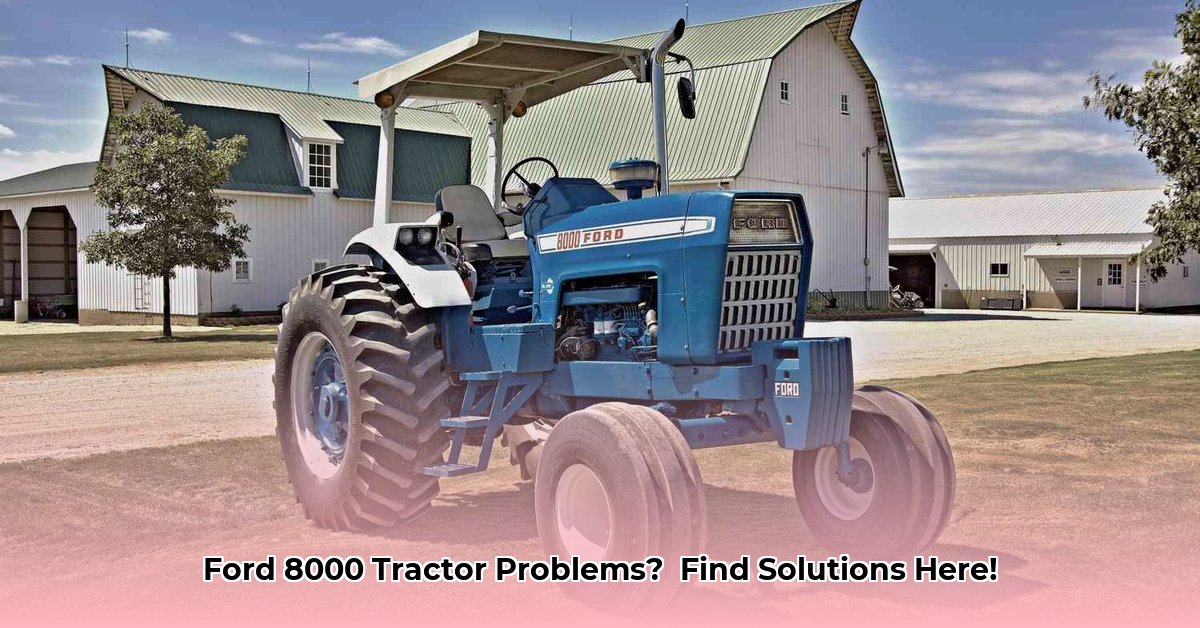
The Ford 8000 tractor holds a unique place in agricultural history. Renowned for its power and relatively low initial cost, it also carries a reputation for specific mechanical challenges, particularly with its hydraulics. For more information on Ford tractors, check out this helpful resource: Ford Tractor Data. This comprehensive guide will equip both prospective buyers and current owners with the knowledge to navigate the complexities of this iconic machine.
Weighing the Pros and Cons: A Balanced Assessment
The Ford 8000 offers undeniable advantages: significant horsepower for demanding tasks, generally intuitive controls, and often a surprisingly affordable purchase price. However, potential buyers must acknowledge the documented weaknesses. Reports consistently highlight issues with the hydraulic system, the dual power system, and the 3-point hitch.
| Feature | Advantages | Disadvantages |
|---|---|---|
| Horsepower | High horsepower ideal for heavy-duty applications. | Not a significant problem area, generally. |
| Ease of Operation | Relatively simple controls, user-friendly for many. | Ease of use can depend on experience level. |
| Purchase Price | Often available at a competitive price point. | Potential repair costs can significantly increase overall expenses. |
| Hydraulic System | Adequate performance in later models. | Leaks and failures are frequently reported, especially in older models. |
| Dual Power System | Useful feature when functioning correctly. | Problems with shift forks and PTO splines are documented recurring issues. |
| 3-Point Hitch | Generally functional. | Issues impacting implement operation have been reported. |
| Parts Availability | Many parts are readily available. | Sourcing parts for older models may be more challenging. |
Buyer's Guide: A Pre-Purchase Inspection Checklist
Before purchasing a used Ford 8000, a thorough inspection is essential. This proactive approach can save you significant time and money down the line:
Hydraulic System Assessment: Inspect all hoses and cylinders for leaks, cracks, or damage. Listen for unusual noises during engine operation. Low hydraulic pressure is a common problem; a pressure test is highly recommended. (A pressure gauge is essential for accurate assessment). A failing hydraulic system represents a substantial repair cost.
Dual Power System Functionality: Test the PTO (power take-off) extensively. Smooth, consistent operation is crucial; any hesitation or rough engagement suggests potential problems requiring attention.
3-Point Hitch Examination: Raise and lower implements multiple times, verifying smooth movement and secure attachment. Stiffness or binding indicates potential issues that could limit functionality.
Service History Review: If available, acquire and thoroughly review the tractor's service records. This provides invaluable insights into its maintenance history and can highlight potential problem areas.
Budgetary Considerations: Factor in a significant contingency budget for potential repairs. A seemingly inexpensive purchase can quickly become costly if major repairs are required immediately. This is a must-have to avoid financial surprises.
Owner's Guide: Proactive Maintenance Strategies
For current Ford 8000 owners, a proactive maintenance schedule is critical for maximizing operational life and minimizing expensive repairs:
Adhere to the Recommended Maintenance Schedule: Follow the manufacturer's recommended maintenance schedule diligently, including regular oil changes, filter replacements, and thorough inspections. Preventative maintenance is far less costly than repairs.
Hydraulic System Monitoring: Regularly check the hydraulic fluid level and condition. Address any leaks promptly. Consider upgrading to a higher-efficiency filter, especially on older models, to minimize contamination.
Dual Power System Inspections: Periodically inspect all components of the dual power system for wear and tear. Early detection of problems prevents major breakdowns.
3-Point Hitch Lubrication: Ensure proper lubrication of the 3-point hitch components to guarantee smooth operation and extend its lifespan. This simple step often overlooked can greatly improve overall performance.
Conclusion: Realistic Expectations and Informed Decisions
The Ford 8000 remains a powerful tractor capable of significant work, but its inherent challenges require realistic expectations. A thorough pre-purchase inspection and a commitment to proactive maintenance are essential for both prospective buyers and current owners. By understanding the potential problems and taking preventative measures, you can significantly increase the chances of a long and productive partnership with this iconic machine.